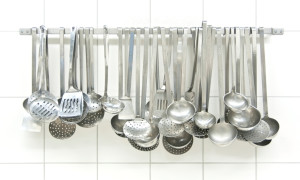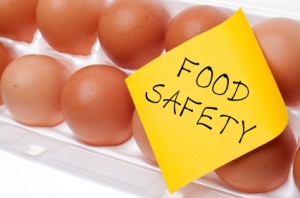An ever-present aspect of the food service industry is the inevitable visit from the local health inspector. All too often restaurants fall into the habit of just squeaking by when it comes to inspections, doing the bare minimum to pass, instead of regularly putting good food safety procedures into practice. I’m here to give you a few pointers geared towards maintaining a restaurant that keeps food safety, for customers and staff, at the forefront.
Food borne illnesses are suffered by an estimated 81,000 people every year, according to the FDA. Additionally, 9,000 deaths result from preventable food-related illnesses, and food borne pathogens still stand as the leading cause of emergency room visits in the United States.
With this in mind, are you doing what’s best for your customers when it comes to serving them food
There are 4 acceptable options for storing your “in-use” utensils:
- In the food with the handle extended out
- In a dry, clean place
- In a dipperwell or similar appliance with potable running water
- Stored in temperatures of 135 degrees F and above, or 41 degrees F and below
As simple as these options are to employ, health inspectors still come across some pretty appalling practices: knives wedged into grease-filled cracks between restaurant equipment, utensils hung from food-encrusted magnetic strips, or serving utensils in standing water with floating debris. Now imagine this from a customer’s standpoint. Disgusting, I know.
Storage of food service utensils goes hand-in-hand with maintaining the quality of those utensils. Always examine the edges of what you’re using. Cracks, chips, breaks, and frays in any of your utensils can lead to a customer finding something unappetizing in their meal like slivers of wood or metal from handles and blades. While these areas can be difficult to clean, they pose the most threat when it comes to food safety. Check these problem areas as you make your kitchen rounds, and train your staff to do the same.
Aside from properly storing your serving utensils there are a number of steps you can take as a manger or staff member that, when combined, will contribute to better food safety practices. If you make food safety an everyday priority then the next time the health inspector stops in you’ll be ready.
 However, if you’re just starting to address aspects of your establishment that might not meet the health inspector’s standards it’s a good idea to conduct your own inspections.
However, if you’re just starting to address aspects of your establishment that might not meet the health inspector’s standards it’s a good idea to conduct your own inspections.
Come in unannounced. Surprise your employees on occasion and come in early. Observe how your staff behaves when you’re not expected, and see if there are any food safety issues that need to be addressed.
Use the local health inspection form. Get your hands on a copy of the local health inspection form to help you understand what criteria the inspector will use to evaluate your restaurant. Familiarize yourself with what they’ll be looking for, and regularly monitor the areas you’re having trouble with.
Conduct a thorough walkthrough. Be as objective as you can and approach your restaurant with fresh eyes. This may be difficult, as it’s often hard to scrutinize something you feel strongly about, but it’s exactly what the health inspector’s going to do.
Speak with your employees. Your employees are the front line of your establishment, and are the ones who will (or won’t) adhere to food safety procedures. View your walkthrough as a training experience for new and old employees alike, being specific about what is acceptable and what is not. This way they’re not as on edge when the inspector comes and will already have the know-how to keep things up to code.
Identify problems and fix them. Easier said than done in some cases, identifying your restaurant’s problem areas and coming up with solutions is more than a one person job. Don’t assume that just because you’ve outlined your food safety strategies with your employees that these strategies are being followed. Make it common practice to re-check for violations, and constantly reward employees for quickly correcting mistakes. With a little enthusiasm you can easily avoid sick customers, and worse yet a lawsuit. It’s a team effort, you’re just the captain.
Do yourself, your staff, and your customers a favor and re-evaluate your food safety program. Flush out potential holes, and commend yourself for things you’re doing well. Practicing proper food safety is just that, a practice. It takes constant attention to detail and a determination to not only “beat” the health inspector but to provide a complete picture of sanitary performance.
 Corner Booth Blog | TundraFMP Restaurant Supply, News & Equipment Blog
Corner Booth Blog | TundraFMP Restaurant Supply, News & Equipment Blog



